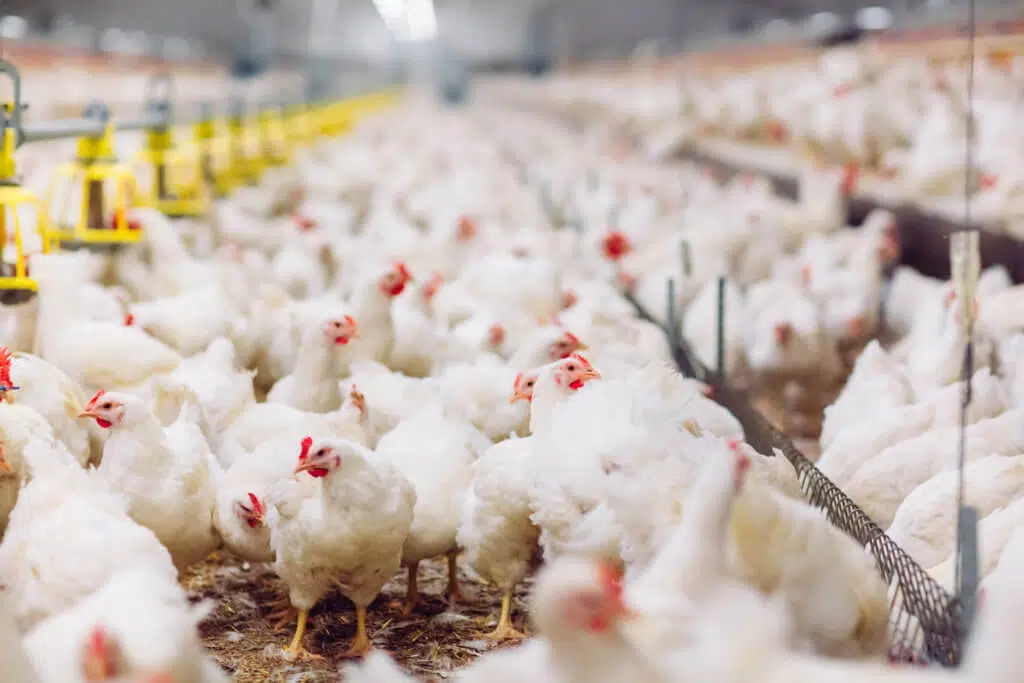The global population is growing rapidly, and it is estimated that feeding the nine billion people expected by 2050 will require a 70% increase in feed production. In order to achieve this, we need to find ways to optimise the process of growth and production. In broiler chickens, the utilisation of dietary protein has historically been less efficient than the digestion of fat and starch in the feed, so this provides an opportunity for improvement through including ABC values in diet formulation.
Understanding protein digestion
Protein digestion begins in the proventriculus and gizzard and is dependent on the maintenance of a low pH for optimal functionality of the main protein-digesting enzyme, pepsin. That is why it is important to consider how feed ingredients affect digestive pH.
The ability of a feed ingredient to buffer acid in the stomach is measured by its acid-binding capacity (ABC). In addition, the buffering capacity of drinking water (its alkalinity) also has an important effect on the pH of the gastrointestinal tract (GIT). If we could formulate poultry diets to a specific ABC value, we may be able to improve protein digestion and gut health in young broilers.
The ABC of a feed is defined as the amount of hydrochloric acid (HCl) required to reduce 1 kg of a feedstuff to the desired pH (pH 3 or pH 4). of three or four.
As easy as ABC (values)
A good early start is vitally important to broiler production due to the strong correlation between seven-day bodyweight and slaughter weight.
Young broilers, including newly hatched chicks, have a higher pH in their stomach, as well as a reduced ability to produce enough acid in the proventriculus compared to older birds. This means they struggle to adjust the pH when consuming diets that have a high ABC value or water with a high alkalinity, resulting in less than optimum protein digestion.
Table 1 A typical broiler diet according to standard formulation methods, including ABC-3 values of raw materials as determined by in vitro research.
| Ingredient | Pre-starter | Starter | Grower | Finisher |
| Maize | 54,75 | 64,05 | 65,86 | 66,95 |
| Soya oilcake (47%) | 32,50 | 23,65 | 20,75 | 18,60 |
| Sunflower oilcake (36%) | 2,50 | 2,50 | 2,50 | 2,50 |
| Full-fat soya | 3,00 | 3,00 | 3,00 | 3,00 |
| Monodicalcium phosphate | 1,13 | 0,67 | 0,49 | 0,50 |
| Limestone (36%) | 1,51 | 1,45 | 1,30 | 1,33 |
| Sodium bicarbonate | 0,20 | 0,23 | 0,22 | 0,22 |
| Salt | 0,21 | 0,18 | 0,20 | 0,19 |
| Soya oil (crude) | 2,88 | 2,14 | 3,10 | 2,77 |
| Other | 1,32 | 2,13 | 2,60 | 3,94 |
| Predicted ABC value (mEq) | 765,50 | 689,32 | 640,73 | 636,61 |
| Calcium (Ca), formulated including phytase Ca | 1,05 | 0,88 | 0,79 | 0,78 |
| Analysable calcium | 0,90 | 0,73 | 0,64 | 0,63 |
| % Limestone calcium in diet | 0,56 | 0,54 | 0,53 | 0,53 |
As seen in Table 1, the ABC-3 value for the pre-starter and starter diets were the highest compared to the other diets, demonstrating that little consideration is placed on the digestive physiology of young birds during standard diet formulation.
Including ABC values in formulation in the future could improve protein digestion, gut health, and broiler performance – taking us a step closer to achieving the vision of producing 70% more food to feed an ever-growing world population.
References
Hinton, A., Corrier, D.E., Ziprin, R.L., Deloach, J.R., Corrier, D.E., 1990. Effect of Dietary Lactose on Salmonella Colonization of Market-Age Broiler Chickens. Am. Assoc. Avian Pathol. 34, 668–676.
Gilani A., 2012. Measurement of Acid‐Binding Capacity for Poultry Feedstuffs in Deionized and Magnetized Water. Iran. J. Appl. Anim. Sci. 3, 687–694.
Angel, R., Kim, S., Li, W., Jimenez-Moreno, E., 2013. Passage rate and intestinal pH in poultry: Implications for enzyme use and digestion. FEDNA.
Innovation manager










